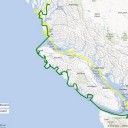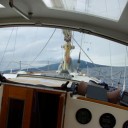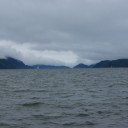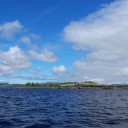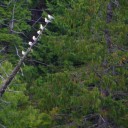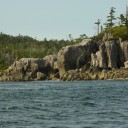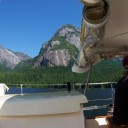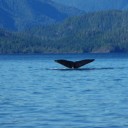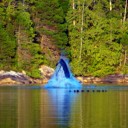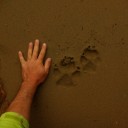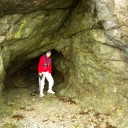Summer Cruise 2012
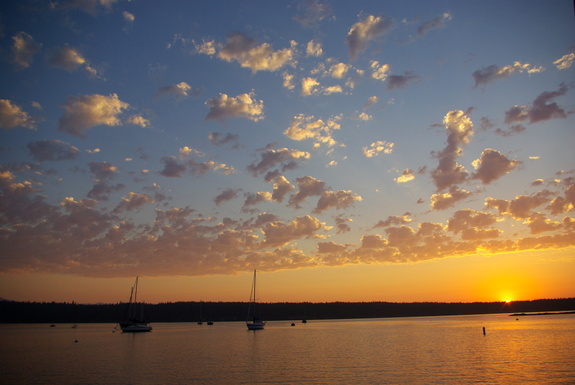
October 1st, 2012 | by Marilyn | Published in Ship's Log
Summer 2012 was a great 3 month trip along the central BC coast, travelling 1500 miles in all. It was the summer of many firsts.
It was the first time we tried out our Monitor Wind Vane (and I loved it from the first use).
It was the first time we anchored at Lasqueti Island – what a great funky place that is, a real sailboat mecca.
It was the first time we sailed in real ocean swells. Quite a change from the protected inland waters, but we all did well (that is, Van and me as well as Rainshadow, who proved she is tougher than we are many times). I am no longer intimidated by the thought of the open ocean (during good weather).
It was the first time we rounded Cape Caution to reach the central BC coast.
It was the first time Van caught a big salmon. 11 lbs 4 ounces to be exact. Yummy dinners!
It was the first time we made it as far north as Roscoe inlet, which is just northeast of Shearwater/Bella Bella. From there we turned around to head for homeport again (which took us 6 weeks to reach).
It was the first time Van went swimming off the boat, and we practiced me hauling him aboard with the life sling. Very reassuring that I could do it.
It was the first time we saw bear on shore. Two nice black bear, eating mussels.
It was the first time we rounded Cape Scott. In fact, we passed Cape Caution and Cape Scott on the same day as we sailed from Smith Inlet to Sea Otter Cove in one long and enjoyable day.
It was the first time we sailed the west coast of Vancouver island. “Sailed” in this case is a euphemism, as of the 10 days that we were on the open ocean during that September journey, we had to motor 8 days due to insufficient wind. There had certainly been big storms elsewhere because huge 10 foot swells ran under us on many of those days – at times with a glass smooth surface because there was no wind. We tried to sail many times when a breath of wind appeared, but the swells just caused the sails to slat horribly. Worst was the times when there was a 5-10 knot following breeze because then the diesel exhaust was blown right into the cockpit. It was tedious at times, and quite a disappointment to be forced to motor for hundreds of miles when we hoped for the “downhill sleigh ride” so many talk about on their south bound trip along the west coast.
It was the first time we exceeded 8 knots of hull speed. This occurred on the day we rounded Brooks Peninsula – which was one of the days we could sail on the west coast of VI. It was a good windy day (as usual for Brooks) – 20-25 knots apparent. After we rounded the peninsula, the mountain range shielded us from the wind temporarily, so Van threw up all the sails. Soon, the wind was screaming down the steep mountain sides and hitting us on beam – I saw 33 knots apparent on the wind meter. I swear the boat almost went airborne as she was lifted by the force on the sails. We sustained more than 8 knots for some time, reaching 8.3 knots peak – and finally I convinced Van to reef some of the sails as we were so overpowered I was having to seriously fight the helm. Van found it exhilarating, while I found it exhausting. We should have traded places.
That night, it was the first time we experienced the full brunt of Williwaws – those high winds that come screaming out of the mountains after hot summer days. We were at Colombia Cove, reportedly a snug harbor but we found it anything but snug. We anchored in only about nominal 20 feet of water in a small space we thought would offer protection, but the winds slammed us from an unexpected direction. First it was just a gust or two. By 2AM, it was a constant 25-35 knots. We drug anchor quite some distance, but fortunately into open water within the bay rather than into the nearby rocks. Definitely a white knuckled night with the anchor alarm alerting us many times to adjust the chain as the tides and winds altered our position.
It was the first time we had a whale swim under our boat while at anchor. Seriously! We were in Mary Basin, which is a huge bay that is only 30 feet deep. A humpback whale was feeding on the copious mackerel in the bay. We watched for probably 30 minutes as it made its way around the bay, slowly getting closer and closer to our anchored position. It was beautiful to watch. Then it surfaced very close to the boat, heading in our direction. Next came the swirling turbulence under the boat, followed by it surfacing on the other side. Van caught it all on video. It didn’t even bump the boat. What graceful creatures! We saw many many whales on this trip, mostly on the west coast but also on the central coast.
It was the first time we navigated in dense fog through reefs (at the mouth of Kyoquot sound), compliments of our GPS. We could hear the crashing waves, but could not see the spray we knew was there as the huge swells smashed into the reefs. GPS are certainly game changers when it comes to navigation. I don’t trust computers, so I always have paper charts at hand, but I never would have chosen a path between those fog-encased reefs if we didn’t have GPS.
It was the first time we went into Barkley Sound – a major destination for many a dreamer. It was nice, but I think we prefer the central BC coast for its solitude.
It was the first time we traveled all night – and unfortunately we chose to do so from Neah Bay to Sequim Bay, which meant we navigated the Straits of Juan de Fuca in the dark. It started out good, a nice breeze lured us into making the decision to sail (since we had gone nuts motoring so many days in the weeks before). We stayed out of the shipping lanes, and alerted VTS (“Seattle Traffic”) about our presence. We sailed into the night, being guided by the stars and the bio luminescence in our wake. It was rather nice at first. By midnight, a dense fog set in and the wind failed. No use looking out from the cockpit, we could barely see our own running lights. I took the opportunity to try get some sleep. It was instruments only as Van motored into the night – he said he felt like it was a video game where ‘game over’ had serious consequences. Dark and fog do not stop the commercial traffic – it was downright crowded out there, with container ships queued at the pilot station at PA. Seattle Traffic was an enormous help as they alerted Van to the traffic coming our way. It turns out that westbound barges hug the south shore once they are west of Dungeness Spit to avoid the constriction in the shipping lanes. That is right where we were navigating to also avoid the shipping traffic. Van got a little close to the spit to avoid collision with an invisible tug (radar showed its position). He then apparently rounded Dungeness Spit just as a cargo ship wake hit him – that is the only explanation we could think of that would cause him to literally do an unintentional 360 turn near the buoy marker as he tried to control the wildly pitching boat in the utter darkness. That was 6 AM. I took over the helm from an exhausted Van as the grey dawn appeared, using the autopilot to avoid steering off course by the disorienting waves. I had to dodge many many crab pots along the east side of the spit – it was a long night. We approach Sequim Bay in pea soup fog, and aborted once at the channel because we couldn’t even see the navigation markers until they were within maybe 30 feet. We anchored just outside the entrance in the uncomfortable chop, and as soon as we completed the anchoring – the fog lifted to revel a sunny shore. We motored in and spent the day recovering from the exhausting ordeal. Don’t think we’ll try that again!
All in all, it was a wonderful journey, and its one we hope to repeat – hopefully this time with better wind in September.
There is one other first – it’s the first time we moored our boat and left for the winter to live in the warmer climate of Hawaii, leaving Rainshadow to fend for herself in the PNW winter. That’s why there is no report of what we did to improve Rainshadow in the winter of 2012-13.
- Inside passage outbound, west coast Vancouver island inbound
- Strait of Georgia under sail
- This was a motoring day because there is no wind
- Tacking up Johnstone Strait, along with several other sailboats
- Another decent sailing day
- At least this species of seagulls sits in trees
- Central BC area
- Hot sunny day with the cockpit canvas rolled up
- Another gorgeous whale sighting
- This whale swam under our boat while anchored in Mary Basin
- We went ashore on an island in Barkley Sound just after a huge wolf had been there
- Nice sea cave in Barkeley Sound
